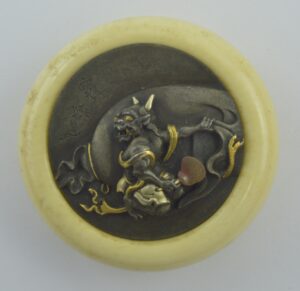NETSUKE: Miniature Marvels
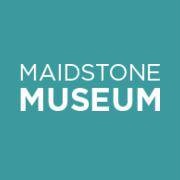
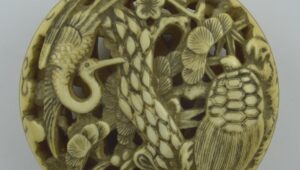
NETSUKE: Miniature Marvels
In this blog, Samantha Harris (Collections Manger), looks at some of the miniature works of art in the Japanese Collection which are often no more than 3 – 5cm in size! The beautiful and functional art form – Netsuke.
What does a netsuke do? Function and purpose
In Japanese clothing, Kimono didn’t have pockets, so personal items such as purses and pipes were hung from the obi belt and secured with ornamental toggles called netsuke. They were worn by men from all levels of society, but particularly during the Edo period (1600-1868) by the merchant class, when they expressed the personalities of their makers and owners. Netsuke came to be a uniquely Japanese item and art form.
This close up of a woodblock print from the collection shows a netsuke in use, a man (a footman) has an item, possibly a red bag, hanging from his belt secured by a lightly coloured netsuke:
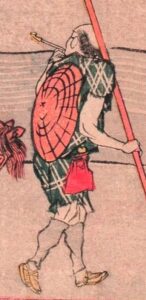
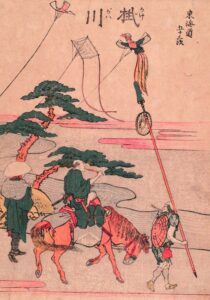
The Fifty-Three Stations of the Tokaido (Tokaido gojusan tsugi). Kakegawa. Three men travel along by a river, one man is on horseback and smokes a pipe. The man leading the way is a footman (yakko) and carries a standard. The men admire the kites flying in the sky. Woodblock Print. Materials: Ink and watercolour. Creator: Hokusai, Katsushika (葛飾北斎) (Samuel Print No 550 / MNEMG.TEMP.2016.844; Samuel Collection)
The group of ‘hanging objects’ are known as Sagemono and included Inro, small, decorative boxes for carrying coins and medicine. See a blog on other forms of Japanese Sagemono in the collection here: https://museum.maidstone.gov.uk/stylish-accessories/
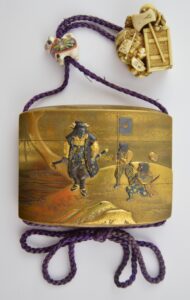
Inro. Broad, gold lacquer fundame inro with 2 cases. Decorated in high and low-relief lacquer in shades of gold with design inspired by the story of Momotaro, the ‘Peach Boy’. The famous strong samurai boy, Momotaro is accompanied by his companions: a dog, pheasant and monkey. Pear-skin (nashiji) and fundame interior. Signed on base in gold lacquer. Inro has netsuke attached of carved ivory in the form of a chest of weapons or tools (MNEMG 1979.42.5), and a ceramic ojime in the shape of a small white dog. Materials: Gold lacquer. Creator: Koma Koryu (MNEMG 1979.122.50.A; Samuel Collection)
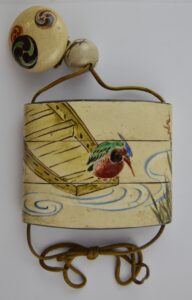
Inro. Wide ceramic inro with 2 cases. Beige-coloured ceramic with white glaze and red, blue, green and brown enamel decoration. On one side, a kingfisher (kawasemi) perches on a boat and looks down into the swirling water. Attached to the inro is a matching ceramic netsuke (manju) (MNEMG 1979.42.I), and an ojime that is decorated with a design of wild geese. All are signed ‘Kenzan’. The design appears in the woodblock-printed book ‘Korin Hyakuzu’ published in 1826 with illustrations by Hoitsu (1761-1828). Materials: Ceramic. Creator: Signed Kenzan but could be attributed to Miura Ken’ya (1821-89) or Ken’ya II (1853-1923), a pupil of Ken’ya I who was adopted by the Ogata family as Kenzan VI (MNEMG 1979.122.67; Samuel Collection)
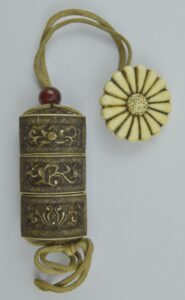
Inro with netsuke in chrysanthemum form. Small, carved ivory inro. Each case decorated with rectangular panel, bordered with basket pattern, containing scrolling flowers and leaves on pierced ground showing wood lining. Ivory has been stained black. Black lacquer and fundame interior. Cream cord with red ojime bead attached. Materials: Ivory; Wood (MNEMG 1979.122.40; Samuel Collection)
Types of netsuke
There are 3 main forms of netsuke represented in the museum collection – Katabori, Manju and Kagamibuta/kagami. We hold around 300 of these fascinating pieces in the collection including examples of all these forms.
The most popular form is Katabori, these are miniature carved sculpture. They are 3D objects on a variety of themes including animals, plants, people, and still life.
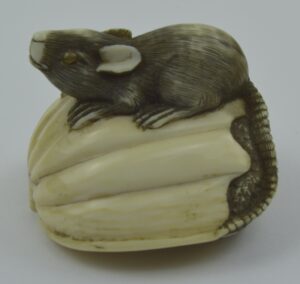
Netsuke (katabori). Rat crouching on large fruit or chestnut. Eyes inlaid in dark material. Details in black stain. Materials: Ivory (MNEMG 1979.41.G; Brenchley Collection)
Manju are the second most common form, they are carved oval or square netsuke. They are named after the similarly shaped rice-cake they resemble.
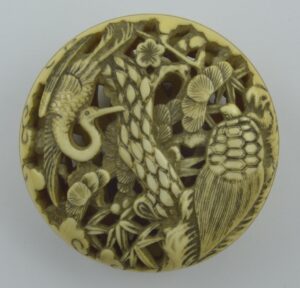
Netsuke (manju). Round two part with carved and pierced design of pine, bamboo and plum (shochikubai), crane and minogame. Materials: Ivory (MNEMG 1979.42.M30; Samuel Collection)
The final form is Kagamibuta/kagami, which means ‘mirror lid’. And as the name suggests, are round ivory or wooden mounts with a metal plate inset on top with decoration.
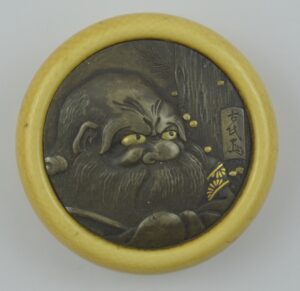
Netsuke (kagamibuta). Ivory frame and shibuichi plate. Engraved with design of face of the tengu king Sojobo next to trunk of pine tree. Signature with kao engraved on front of plate. Materials: Ivory, gold, shakudo (MNEMG 1979.42.KB20; Samuel Collection)
What are they made from? Materials
Netsuke were made from a wide range of materials including wood, ivory, metal, lacquer and ceramic.
Wood was the most popular material, with trees being plentiful in Japan, it was the most readily available material. This included boxwood, ebony, Japanese Cypress, Cherry Persimmon and Bamboo.
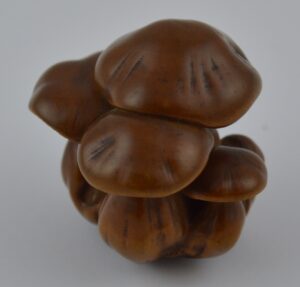
Netsuke (katabori). Five funghi of various sizes, joined at root. Signature on base. Materials: Wood. Creator: Masanao II or III (MNEMG 1979.41.MH; Marsham Collection)
Ivory was also commonly used, with Elephant ivory being particulatly popular. This material was not native to Japan, so was imported during the Edo period (from which most of the netsuke date in the collection) by Chinese and Dutch traders. Stag antler was a more locally available alternative.
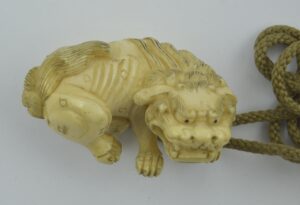
Netsuke (katabori). Emaciated lion-dog (shishi) with boney ribcage, crouched and snarling with loose ball in its mouth. Materials: Ivory (MNEMG 1979.42.Q; Samuel Collection)
Metal netsuke were made by different artisans, professional metalworkers, rather than specialist netsuke makers. These craftspeople may also work on decorative sword fittings and other intricate metal items. Shakudo, a coloured metal alloy of gold and copper, was particularly popular to make metal plates on kagamibuta netsuke.
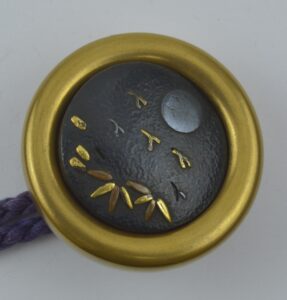
Netsuke (kagamibuta). Lacquer frame and shakudo plate with silver moon, and birds in flight and clumps of bamboo leaves in inlaid coloured metals. Materials: Lacquer, silver, gold, copper (MNEMG 1979.42; Samuel Collection)
A variety of other materials were also used to create these miniature marvels such as lacquer, ceramic, coral, amber and shell.
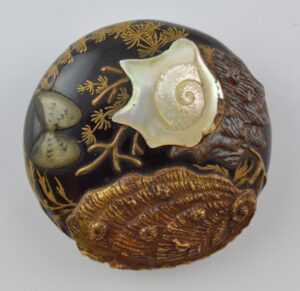
Netsuke (manju). Round hollow with shells and seaweed in gold and brown lacquer in low and high relief (hiramakie and takamakie) upon roiro ground. Signature and kakihan on back. Netsuke is paired with inro (MNEMG 1979.122.31). Materials: Mother-of-pearl shell inlay, gold inlay, lacquer. Creator: Nomura Chohei (MNEMG 1979.42.T; Samuel Collection)
Themes and Designs
The subjects of netsuke were boundless, including nature, people, places, religious subjects, daily life objects, seasons, festivals, theatre and folklore. They are a snapshot into the life of Japanese people in the Edo period, their material culture and popular culture.
Nature
Nature was a popular source of inspiration for netsuke carvers, including animals, birds, sea creatures and insects. This was not least due to the Shinto worshipping of nature, the symbolism of animals in Japanese culture, and the East Asian zodiac calendar, based on 12 animals. The style for many of the netsuke in the collection is quite naturalistic. With Japan’s close relationship with the sea, it is unsurprising that fish and sea creatures feature in many netsuke in the museum’s collection.
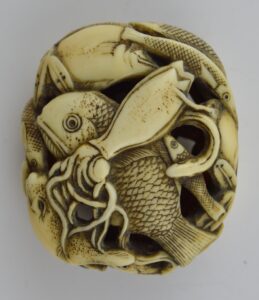
Netsuke (manju). Hollow oval carved and pierced with fish, squid and other sea creatures. Materials: Ivory (MNEMG 1979.42.V; Samuel Collection)

Netsuke (katabori). Red glazed octopus in jar covered with white glaze almost to bottom where unglazed clay showing at base. Materials: Ceramic. Creator: possibly, Ketusji (MNEMG 1989.129.1; Samuel Collection)
Mammals too feature on netuske, from realistic rats to stylised tigers.
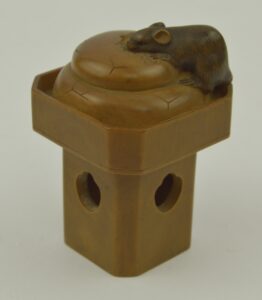
Netuke (katabori). Square table with large mochi cakes on round top. Small rat eating top cake. Dark inlay for eyes. Engraved signature on back. Materials: Wood. Creator: Masakatsu (MNEMG 1989.129.116)
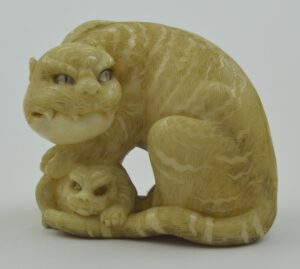
Netsuke (katabori). Carved tiger sits with head turned to left and one front paw on cub, engraved hair, inlaid eyes. Signature engraved underside of leg: “Gyonen 73 Fusai” (73 years, Fusai). Materials: Ivory. Creator: possibly Fusai (MNEMG 1979.122.3; Samuel Collection)
Insects and Turtles too had symbolism in Japanese culture, and were common themes for netsuke.
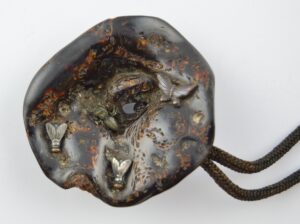
Netsuke (katabori). Carving of fungus inlaid with spider, butterfly and two flies. Attached to inro in shape of tobacco pouch (MNEMG 1989.129.28). Materials: Wood, lacquer, silver, copper (MNEMG 1979.42.Y; Samuel Collection)
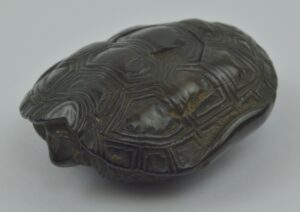
Netsuke (katabori). Turtle with head and limbs drawn into shell. Himotoshi in centre of shell. Dark brown in colour. Signature on base. Materials: Ivory. Creator: Tazan (MNEMG 1979.42.KB1; Samuel Collection)
People
During the isolation of Japan in the Edo period, it was rare for a Japanese person to see a foreigner, so traders such as the Chinese and Dutch, were the subject of much curiosity and portrayed with set characteristics, such as the Dutch with wide brimmed hats, often carrying cockerels! Netsuke of this type were made for a short period from 1750s – 1800. The cockerel denoted the popular sport of cock fighting at the time.
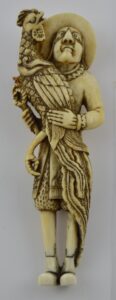
Netsuke (katabori). Standing figure of a Dutchman in typical wave-patterned coat and large brimmed hat of 17th Century style, gripping cockerel with long tail feathers. Materials: Ivory. (MNEMG 1979.41.A; Brenchley Collection)
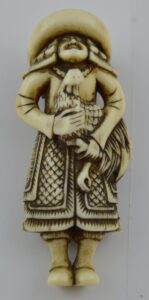
Netsuke (katabori). Standing figure of a Dutchman in typical wave-patterned coat with many buttons of 17th Century style, gripping cockerel. Materials: Ivory (MNEMG 1979.41.B; Brenchley Collection)
Native Japanese people were also represented, often undertaking tasks in daily life, or with a sense of humour!
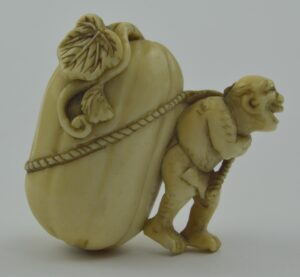
Netsuke (katabori). Hairy, laughing man in loincloth dragging huge gourd after him by rope. Materials: Ivory. Creator: Naokazu (MNEMG 1959.3.B; Carnegy Collection)
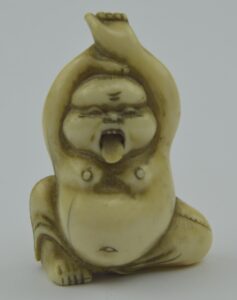
Netsuke (katabori). Otafuku (Okame) imitating daruma. Okame’s half-naked figure is depicted crouching and yawning with arms stretched above her head. A small, articulated tongue sticks out of Okame’s mouth. Materials: Ivory (MNEMG 1979.41.MI; Marsham Collection)
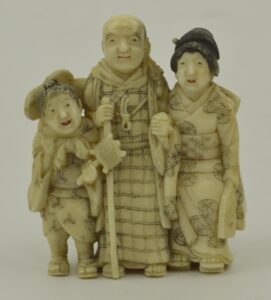
Netsuke (katabori). Family, father in centre, mother at one side, son at other with kite. Stained ivory with accents of black and red. Signed on base: Kozan. Materials: Ivory (MNEMG 1979.41.F; Brenchley Collection)
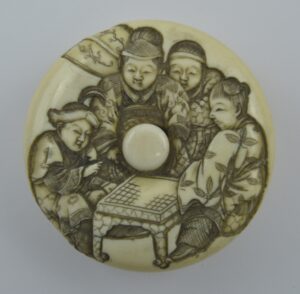
Netsuke (manju). Round ivory netsuke with peg himotoshi. Scene of four figures seated around a low table with Go board. Two Chinese children (karako) play Go watched by two others. Materials: Ivory (MNEMG 1979.42.M19; Samuel Collection)
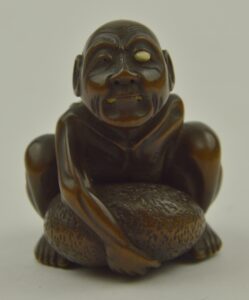
Netsuke (katabori). Wood carving of amma (blind masseur) crouching to lift large stone to build up arm muscles. 1 eye in ivory. Engraved and red stained ivory tablet on base. Materials: Wood. Creator: Gyokkei (MNEMG 1979.41.MN; Marsham Collection)
Religious subjects
The concept of Immortals or Sennin was popular in China and Japan where they were often depicted as eccentric men and women. Forms of the Immortals and The Seven Gods of Good Fortune or Shichifukujin (which are deities of Buddhist origin), were therefore often carved in netsuke. These figures are represented in the museum’s netsuke collection, most notably in this intricately carved treasure ship carrying the seven lucky gods (Benten, Bishamon, Daikoku, Ebisu, Fukurokuju, Hotei and Jurojin). Even more impressive when you consider its tiny size!
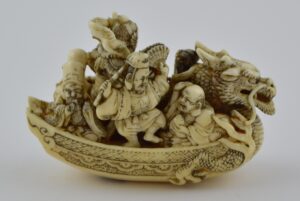
Netsuke (katabori). Carving of the treasure ship (takarabune), a dragon-headed ship with the seven lucky gods (shichi fukujin) on board. Materials: Ivory. Creator: Fujiwara Masanobu (MNEMG 1979.41.MF; Marsham Collection)
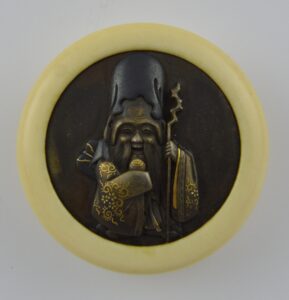
Netsuke (kagamibuta). Frame and shibuichi plate decorated with figure of lucky god Fukurokuju holding staff, uchiwa and tama. Materials: Ivory, gold, shakudo inlay (MNEMG 1979.42.KB9; Samuel Collection)
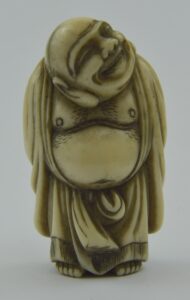
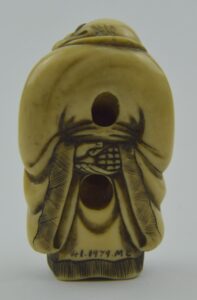
Netsuke (katabori). Hotei standing with head on one side and laughing and hands behind back. Materials: Ivory (MNEMG 1979.41.MT; Marsham Collection)
Netsuke (kagamibuta). Ivory frame and shibuichi plate. Futen, the god of wind, looks furtively over his shoulder and opens his bag of wind. Futen is depicted kneeling with an uchiwa fan in his hand. Signature engraved front right of plate. Materials: Ivory, gold, silver, copper. Creator: Hosho (MNEMG 1979.42.KB10; Samuel Collection)
Theatre and Folklore
Theatre was popular among most levels of society in the Edo period, Kabuki and No were two very different forms of entertainment, so netsuke representing aspects of the performing arts, such as actors, dancers or masks became popular.
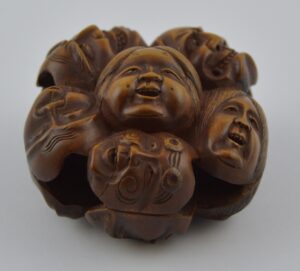
Netsuke (manju). 11 masks, of Otafuku (Okame), Shojo, Hiottoku, Okina and others, form a hollow manju. Materials: Wood (MNEMG 1956.22.A; Todd Collection)
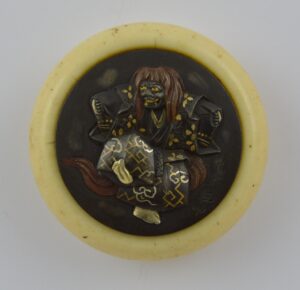
Netsuke (kagamibuta). Frame and shibuichi plate. A performer dressed as the red-haired sprite Shojo. The performer wears a demon’s mask and a long red wig. Signature ad kakihan engraved front right plate. Materials: Ivory, gold, silver, copper. Creator: Shigyoku or Seisei Mingyoku (MNEMG 1979.42.KB33; Samuel Collection)
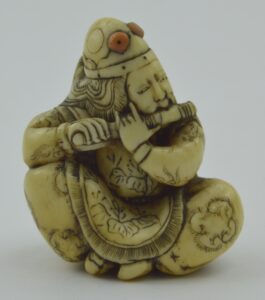
Netsuke (katabori). Seated flute player in headress of Bugaku orchestra members. Signature on base (unread). Materials: Ivory (MNEMG 1979.41.K; Brenchley Collection)
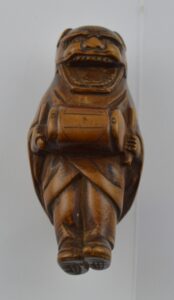
Netsuke (katabori). Shishimai dancer in mask and cloak standing holding drum. Materials: Wood (MNEMG 1979.42.W; Samuel Collection)
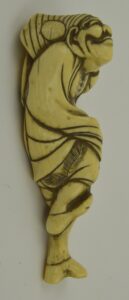
Netsuke (katabori). Ivory carving of Sambaso dancer in characteristic headdress and robe with pine and crane pattern. Materials: Ivory (MNEMG 1979.122.1; Samuel Collection)
Figures and monsters (bakemono) from Japanese folklore were also common subjects represented on netsuke which captured the public imagination.
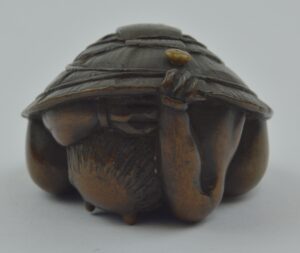
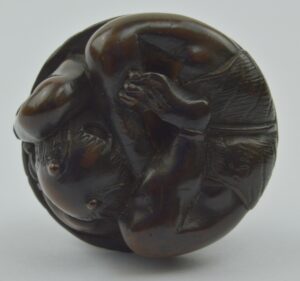
Netsuke (katabori). Carved devil (oni) crouching under large straw hat. The oni shelters from the beans that have been thrown at it during the Oni Yarai exorcism ceremony at Setsubun. Setsubun is now held on the 3rd February at the beginning of spring. On the hat the beans are inlaid with gold. Signature engraved underside. Materials: Wood. Creator: Shogyoku (MNEMG 1989.129.4)
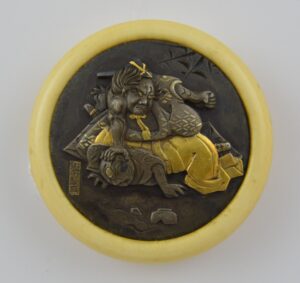
Netsuke (kagamibuta). Frame and shibuichi plate depicting Minamoto no Yorimitsu, also known as Raiko, overcoming the one-eyed monster Ichimoku. A broken bowl and spider web appear in the composition. Signature and kakihan engraved front. Materials: Ivory (MNEMG 1979.42.KB19; Samuel Collection)
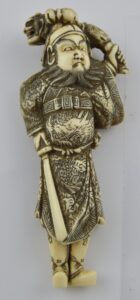
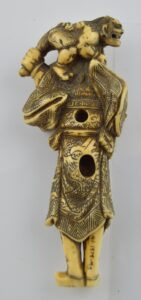
Netsuke (katabori). Shoki, the demon slayer, standing with sword in one hand, other hand holds leg of oni which climbs over his head. Materials: Ivory (MNEMG 1979.41.MG; Marsham Collection)
Craftsmen and centres of production
When the capital of Japan moved from Kyoto to Edo (now Tokyo) in the Edo period (1615-1868), Edo developed into one of the largest cities in the world, and as such attracted both skilled craftsmen to create netsuke, as well as a popular consumer market. Amazing skill was needed to carve such tiny items, with these very intricate designs. Other centres included Osaka (a commercial centre) and Kyoto (a cultural centre), with styles varying between them. As well as these large city centres, some smaller areas and towns developed netsuke production due to good local supplies of materials.
Many of the netsuke in the museum collection have the signatures of their makers, though in some cases, these may not be original or accurate. It is not unheard of for carvings to be given the names of more well-known artists to gain a higher price! For example, Ōhara Mitsuhiro was one of the greatest netsuke carvers of the 19th century in the Osaka region, and was imitated, as the below netsuke from the museum collection shows.
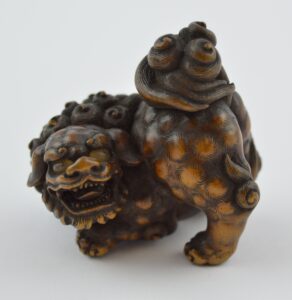
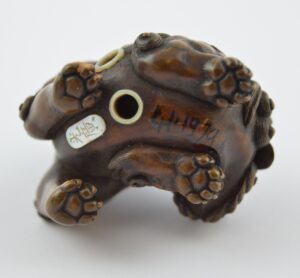
Netsuke (katabori). Chinese lion (shishi) crouching and snarling with head turned to left. Tanba School (Sasayama). A mother-of-pearl signature plaque has been added to the base, which attributes the work to ‘Mitsuhiro’. However, this is possibly the work of Masahide. Materials: Wood. Creator: Masahide (possibly) (MNEMG 1979.41.H)
While carvers such as Masanao were noted for their realistic animal netsuke in Kyoto.
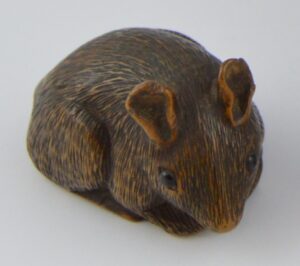
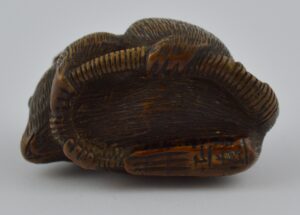
Netsuke (katabori). Carved rat in light coloured wood crouching and holding tail in front paws, inlaid eyes. Signature engraved underside hind leg. Materials: Wood. Creator: Masanao II (MNEMG 1979.124.8.A; Samuel Collection)
Not all netsuke were signed by their makers, though other named craftsmen in the collection include Toyomasa (or in the style of), Masahiro, Tomoyoshi, Shunkosai Anraku, Masakatsu, Nobumasa and Shibayama Soichi:
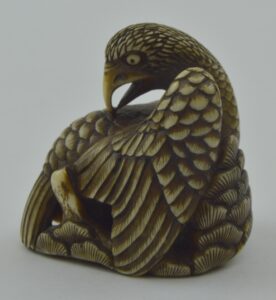
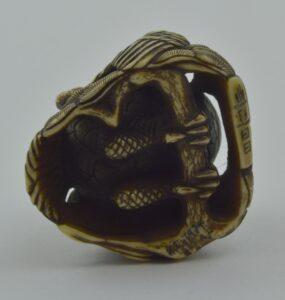
Netsuke (katabori). Eagle perched on pine branch looking over shoulder. Signature on base. Materials: Ivory. Signed Toyomasa. Creator: After Toyomasa (emulates work by Naito Toyomasa, who originally produced this design in wood) (MNEMG 1979.42.AF; Samuel Collection)
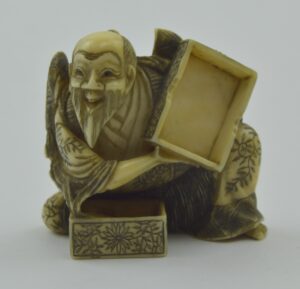
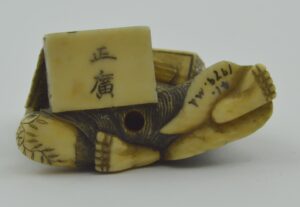
Netsuke (katabori). Urashima Taro, turned into an old man after opening box, from which smoke rises. Signature on base. Materials: Ivory. Creator: Masahiro (MNEMG 1979.41.MD; Marsham Collection)
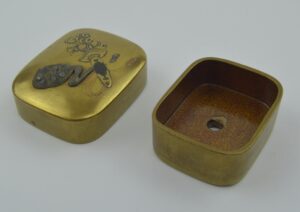
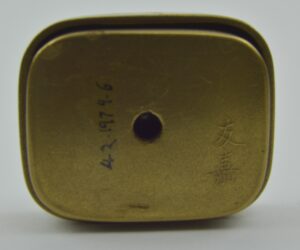
Netsuke (hako). Rectangular box with lid fitting down over sides, design of rattle and Okina mask on lid. Signature on base “Yuka” (Tomoyoshi). Materials: Lacquer (MNEMG 1979.42.6; Samuel Collection)


Netsuke (katabori). Carving of a partly peeled corn cob,. Signature engraved back. Materials: Ivory. Creator: Shunkosai Anraku (MNEMG 1979.42.J; Samuel Collection)
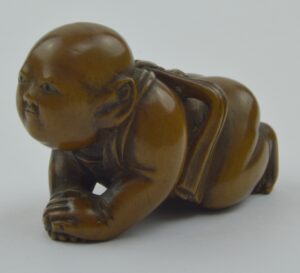
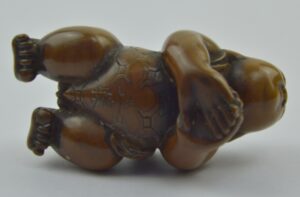
Netsuke (katabori). Carved baby boy crawling, wearing apron-like garment with engraved pattern of octagons and squares. Signature engraved underside. Displayed in Red Cross Exhibition of Japanese Art in 1915. Materials: Wood. Creator: Masakatsu (MNEMG 1979.122.4; Samuel Collection)
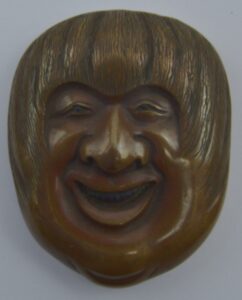
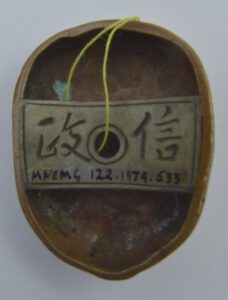
Netsuke (katabori). Grinning shojo mask with shakudo eyes and teeth. Engraved hair. Shibuichi bar across back. Signature engraved on bar at back. Materials: Copper. Creator: Nobumasa (MNEMG 1979.122.533; Samuel Collection)
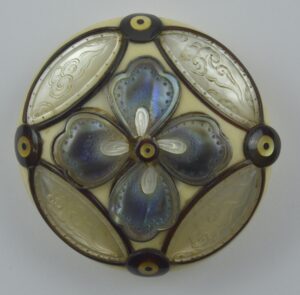
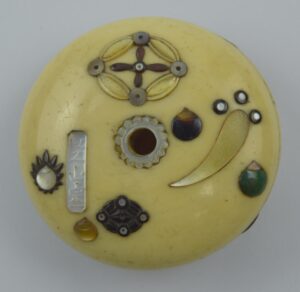
Netsuke (manju). Round 2 part with various inlays. Four petalled flower and coin design in shell. Lucky treasures (takaramono) on reverse in shell inlay. Engraved with signature on reverse inlaid shell tablet. Materials: Ivory. Creator: Shibayama Soichi (MNEMG 1989.129.9)
Collectors
The majority of the Japanese collection was donated to Maidstone Museum by two eminent local collectors of the late 19th and early 20th centuries, Henry Marsham (Donated 1908) and Walter Samuel (Donated 1923-4), giving the collection local as well as national and international significance. Alongside the importance of the objects in their own right, the collection reflects the prevailing European collectors’ taste and present a unique ‘time-capsule’ in the history of collecting Japanese Art, making the collection a primary resource demonstrating Victorian Collecting of Japanese material culture.
Marsham, son of the third Earl of Romney, lived in Japan, and collected in Japan from 1905. He was a collector of great insight, with a sympathy and aesthetic understanding of the Japanese way of life. His interest was primarily in Japanese pottery and he amassed a large collection of unpretentious but attractive domestic non-export wares which are very rarely found in collections outside of Japan. He also collected and donated a small number of netsuke, just under 40 in total.
Samuel, however was the primary donor of netsuke to Maidstone Museum, collecting over 130. Conversely to Marsham, he travelled in Japan extensively because his father’s oil company, Shell Oil, had business interests there. His varied collection of Japanese Art was donated in 1923 via the National Art Collections Fund and included items from famous Victorian collectors including Behrens, Trower and Hawkshaw and was catalogued by the leading expert Mr Henri Joly.
Sources
Hutt, Julia, ‘Japanese Netsuke’, 2016. V&A: London.
Tsuchiya, Noriko, ‘Netsuke: 100 miniature masterpieces from Japan’, 2014. British Museum: London.

